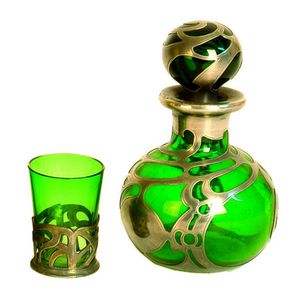Blue Venini Murano Glass Decanter, 1950
Venini, blue sommerso Murano glass decanter designed by Paulo Venini, circa 1950, acid etched mark 'Venini, Murano, Italia', with original paper label 'Venini Made In Italy', 15 cm high, 13 cm diameter
You must be a subscriber, and be logged in to view price and dealer details.
Subscribe Now to view actual auction price for this item
When you subscribe, you have the option of setting the currency in which to display prices to $Au, $US, $NZ or Stg.
This item has been sold, and the description, image and price are for reference purposes only.
- Sommerso - A method of making cased glass developed in Murano in the 1930s, where one or more layers of transparent coloured glass is encased within a layer of thick clear colourless glass.
- Etched - Glass decorated with an etched design, which is achieved through marking out the pattern, protecting the area that is not be etched, and then immersing the object in acid to dissolve the surface of the unprotected area. With some glass objects, such as cameo glass, there may be several layers of different coloured glass, and part of the top layer is dissolved leaving the bottom layer as the background. The longer the time of exposure of the object to acid, the deeper the etching.
The word etching is also sometimes used to describe another method of decoration, where wheel grinders were used decorate the surface, but this technique is usually known as engraving. - Circa - A Latin term meaning 'about', often used in the antique trade to give an approximate date for the piece, usually considered to be five years on either side of the circa year. Thus, circa 1900 means the piece was made about 1900, probably between 1895 and 1905. The expression is sometimes abbreviated to c.1900.
- Acid Etched - Acid etching is often used on glass, metals, and stone to create decorative finishes or to prepare the surface for further treatment or coating. The process of acid etching involves applying an acidic solution, such as hydrochloric acid or nitric acid, to the surface of the material and allowing it to react with the surface. The acid etches away a thin layer of the material, creating a rough, uneven finish. Acid etching can be used to create a variety of different finishes, from a subtle matte finish to a more pronounced, textured finish.
This item has been included into following indexes:
Visually similar items

Anneke Borren, blue platform vase, 2008, height 14 cm
Sold by
in
for
You can display prices in $Au, $US, $NZ or Stg.

A Murano Venezia Aqua glass round decanter, height 15 cm
Sold by
in
for
You can display prices in $Au, $US, $NZ or Stg.

An early 29th century European green glass and silver overlay perfume bottle, spherical body, Art Nouveau whiplash silver work
Sold by
in
for
You can display prices in $Au, $US, $NZ or Stg.

19th century ruby glass onion shaped jar and lid
Sold by
in
for
You can display prices in $Au, $US, $NZ or Stg.
